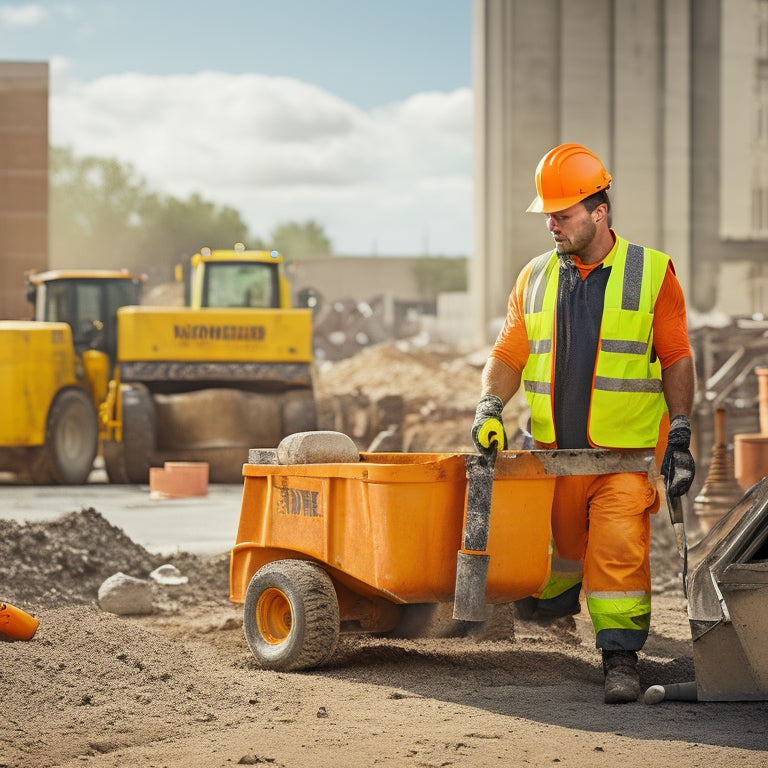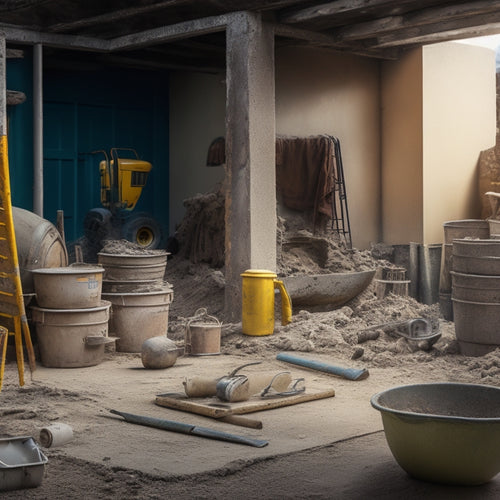
Concrete Removal Tools and Step-by-Step Process
Share
As you prepare for your concrete removal project, you'll need the right tools, including diamond-blade saws, hydraulic breakers, wrecking bars, and chisels, to efficiently cut, break, and remove concrete blocks. Don't forget essential safety gear like protective goggles, gloves, and a dust mask to prevent injuries. You'll also need to choose the best demolition method, whether it's controlled, mechanical, hand, or chemical, depending on the project's specifics. From there, you'll use tools like jackhammers, hammer drills, and pry bars to break and remove blocks, and then clean up debris with brooms, vacuums, and proper disposal methods. Now that you have a solid foundation, you're ready to take the next step towards a successful concrete removal project.
Key Takeaways
• Utilize diamond-blade saws, hydraulic breakers, and wrecking bars to efficiently demolish and remove concrete blocks.
• Wear protective gear, including goggles, gloves, and a dust mask, to ensure safety during the removal process.
• Choose the appropriate demolition method (controlled, mechanical, hand, or chemical) based on project considerations such as concrete strength and thickness.
• Break and remove concrete blocks using tools like jackhammers, hammer drills, pry bars, and chisel sets, taking necessary safety precautions.
• Thoroughly clean up debris and dispose of materials properly, following local regulations, to prevent hazards and ensure a clean work area.
Concrete Block Demolition Tool Essentials
When tackling concrete block demolition, you'll frequently rely on a set of essential tools to guarantee efficient and safe destruction of the concrete structure. These tools are specifically designed to simplify the demolition process, making it faster and more effective.
Among the most critical tools for block cutting are diamond-blade saws, which can cut through concrete blocks with ease. These saws are typically powered by gasoline or electricity and come in various sizes to accommodate different block sizes.
In addition to saws, you'll need demolition equipment such as hydraulic breakers, also known as jackhammers, to break up the concrete blocks into manageable pieces. These breakers are attached to an excavator or a skid-steer loader, providing the necessary force to crush the concrete.
Other essential tools include wrecking bars, pry bars, and chisels, which are used to remove debris and dislodge blocks. By having these tools at your disposal, you'll be well-equipped to tackle even the most challenging concrete block demolition projects.
Safety Precautions and Protective Gear
You must prioritize safety precautions and wear protective gear when operating concrete removal tools to prevent injuries and guarantee a hazard-free demolition process. You're dealing with heavy machinery, loud noises, and flying debris, so it's vital to take necessary measures to safeguard yourself.
First, wear protective goggles to shield your eyes from dust, debris, and other particles that may be released during the demolition process. Additionally, wear safety gloves to protect your hands from cuts, abrasions, and punctures. These gloves should be heavy-duty, puncture-resistant, and provide grip to prevent slipping.
Make sure you wear long-sleeved shirts, long pants, and closed-toe shoes to prevent skin exposure. A dust mask or respirator is also essential to prevent inhalation of harmful particles.
Remember to inspect your tools and equipment before use to verify they're in good working condition. Always follow the manufacturer's instructions and guidelines for operating the tools.
Demolition Methods and Techniques
For effective concrete removal, it's essential to select the right demolition method and technique, as different approaches are suited to specific types of concrete, structures, and project requirements.
You'll need to take into account factors like the concrete's strength, thickness, and reinforcement, as well as the surrounding environment and any potential hazards.
Here are some common demolition methods and techniques you may use:
-
Controlled demolition: This method involves using specialized equipment, like hydraulic breakers, to carefully dismantle the concrete structure in a controlled manner. This approach is ideal for projects that require precision and minimal damage to surrounding areas.
-
Mechanical demolition: This technique involves using heavy machinery, like excavators or cranes, to break up the concrete into manageable pieces. Mechanical demolition is often used for larger projects or those that require more force.
-
Hand demolition: This method involves using hand tools, like jackhammers or chisels, to break up the concrete. Hand demolition is often used for smaller projects or those that require more precision.
- Chemical demolition: This technique involves using chemicals to break down the concrete. Chemical demolition is often used for projects that require minimal noise and vibration.
Breaking and Removing Concrete Blocks
Selecting the right tools and techniques is essential for efficiently breaking and removing concrete blocks, whether you're working on a small-scale renovation or a large-scale demolition project. You'll want to choose tools that can handle the job without causing unnecessary damage or safety risks.
| Tool | Description | Application |
|---|---|---|
| Jackhammer | Pneumatic tool that breaks up concrete | Large-scale demolition, thick concrete blocks |
| Hammer Drill | Electric drill with hammering action | Smaller concrete blocks, precision demolition |
| Pry Bar | Long, sturdy bar for prying and lifting | Removing blocks from walls or floors |
| Chisel Set | Set of hand tools for breaking and removing concrete | Manual demolition, small-scale projects |
| Safety Gear | Protective equipment, including gloves and safety glasses | All concrete removal projects |
When breaking and removing concrete blocks, it's vital to take into account block removal techniques that prioritize safety and efficiency. For example, you may need to use a combination of tools to break up the concrete, then pry the blocks loose and remove them. Don't forget to take into account concrete block recycling options, which can help reduce waste and minimize environmental impact. By choosing the right tools and techniques, you'll be able to complete your project quickly and effectively.
Cleaning Up Debris and Disposal
With the concrete blocks broken up and removed, it's essential to tackle the often-overlooked task of cleaning up debris and disposal. Lingering rubble can pose safety hazards and hinder further construction progress. You don't want to risk accidents or delays due to scattered debris, so take the time to thoroughly clean up the area.
To guarantee a thorough clean-up, follow these procedures:
-
Sweep and blow: Use a broom or a leaf blower to remove loose debris and dust from the area.
-
Hand-pick larger pieces: Collect and dispose of larger concrete chunks, rebar, and other materials that can't be swept up.
-
Vacuum or mop: Use a vacuum or mop to remove fine dust and particles that can settle on the surface.
- Dispose of debris properly: Follow local regulations for debris disposal, and consider recycling or repurposing materials whenever possible.
Frequently Asked Questions
Can I Reuse Removed Concrete Blocks for Another Project?
You're wondering if you can breathe new life into those removed concrete blocks. The answer is yes, you can explore reuse options.
Consider creative repurposing: break them down into aggregate for new concrete, use them as a base material for landscaping, or even transform them into planters or garden features.
Get creative and give those blocks a second chance, reducing waste and adding a personal touch to your next project.
How Do I Handle Buried Utilities During Demolition?
You're about to commence on a demolition project, but did you know that an estimated 40% of excavation damages occur due to inadequate utility detection?
To avoid this, you'll need to handle buried utilities with care. You'll want to employ utility detection methods like ground-penetrating radar or electromagnetic locating to identify hidden pipes and cables.
Then, take necessary safety precautions like marking the locations and hand-digging around them to guarantee a safe and successful demolition.
What Is the Best Way to Dispose of Asbestos-Contaminated Concrete?
When handling asbestos-contaminated concrete, you must prioritize safe disposal to avoid environmental and health hazards.
Familiarize yourself with local asbestos regulations to guarantee compliance.
You'll need to contain the material in leak-tight bags or wrap it in plastic sheeting, then label it as hazardous waste.
Dispose of it at a licensed facility that accepts asbestos-containing materials.
Do I Need a Permit to Remove Concrete From My Residential Property?
You'll need to check with your local government to determine if you need a permit to remove concrete from your residential property.
Permit requirements vary depending on residential regulations in your area. Typically, permits are required for large-scale projects or those that involve structural changes.
You'll want to review your local ordinances and zoning laws to guarantee compliance.
Don't risk fines or penalties - obtain the necessary permits before starting your concrete removal project.
Can I Rent Concrete Removal Tools Instead of Buying Them?
Imagine yourself as a DIY warrior, armed with a sledgehammer, ready to take on the concrete behemoth. But, before you start swinging, consider this: can you really afford to buy all the necessary tools?
Probably not. That's where tool rental comes in. Compare the cost of renting a demolition robot (yes, that's a thing) to buying one, and you'll see the wisdom in renting.
Crunch the numbers, and you'll find that renting is the way to go, saving you cash and sanity.
Conclusion
As you stand victorious amidst the rubble, your concrete removal mission accomplished, remember that the real battle was won in the planning and preparation stages.
Like a medieval knight donning armor, you suited up with the right tools and safety gear.
Your strategic demolition methods and techniques left the concrete blocks in ruins.
Now, as you sweep away the debris, you're left with a blank canvas, ready for the next project to unfold.
Related Posts
-

Must-Have Handheld Tools for Concrete Repair
When tackling a concrete repair project, it is crucial to have the right handheld tools to achieve a professional fin...
-

Essential Power Tools for DIY Concrete Sculpting
As you begin DIY concrete sculpting, you'll need a strategic selection of power tools to achieve professional-grade r...
-

What Tools Are Needed for Concrete Wall Foundations
You'll need a thorough array of tools and equipment to construct a concrete wall foundation that meets structural int...


